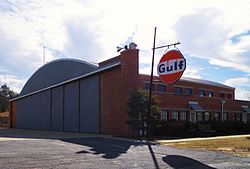The Tuskegee Airmen were a group of African American military pilots and airmen who fought in World War II. They formed the 332nd Fighter Group and the 477th Bombardment Group (Medium) of the United States Army Air Forces (USAAF). The name also applies to the navigators, bombardiers, mechanics, instructors, crew chiefs, nurses, cooks, and other support personnel. The Tuskegee airmen received praise for their excellent combat record earned while protecting American bombers from enemy fighters. The group was awarded three Distinguished Unit Citations.

The Tuskegee Airmen is a 1995 HBO television movie based on the exploits of an actual groundbreaking unit, the first African-American combat pilots in the United States Army Air Corps, that fought in World War II. The film was directed by Robert Markowitz and stars Laurence Fishburne, Cuba Gooding Jr., John Lithgow, and Malcolm-Jamal Warner.

Sharpe Field is a closed private use airport located six nautical miles northwest of the central business district of Tuskegee, a city in Macon County, Alabama, United States. This airport is privately owned by the Bradbury Family Partnership.

Milton Pitts Crenchaw was an American aviator who served with the Tuskegee Airmen during World War II and was the first Arkansan to be trained by the federal government as a civilian licensed pilot. He served during World War II as a civilian flight instructor. He was one of the two original supervising squadron members. In 1998 he was inducted into the Arkansas Aviation Hall of Fame. The grandson of a slave, he was known as the "father of black aviation in Arkansas" who broke through color barriers in the military.

Spann Watson was an American military aviator and civil servant who served with the Tuskegee Airmen during World War II. He flew over 30 missions in North Africa, Italy and Southern Europe. On March 2007, Watson attended a ceremony in the U.S. Capitol rotunda, where he and other surviving veterans of the Tuskegee Airmen were honored with the Congressional Gold Medal in recognition of their service. He died on April 15, 2010, aged 93.

Noel Francis Parrish was a brigadier general in the United States Air Force who was the white commander of a group of black airmen known as the Tuskegee Airmen during World War II. He was a key factor in the program's success and in their units being assigned to combat duty. Parrish was born and raised in the south-east United States; he joined the U.S. Army in 1930. He served in the military from 1930 until 1964, and retired as a brigadier general in 1964.

Herbert Eugene Carter was an American military officer of the United States Air Force. He was a member of the original thirty-three members of the Tuskegee Airmen. He flew 77 missions with the Tuskegee Airmen during World War II.

Charles Alfred Anderson Sr., was an American aviator who is known as the Father of Black Aviation. He earned the nickname "Chief" as chief flight instructor of the Tuskegee Airmen.
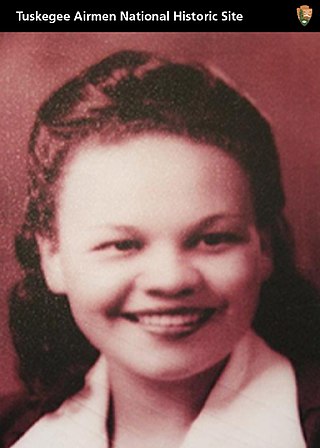
Mildred Louise Hemmons Carter (1921–2011) was one of the first women to earn a pilot's license through the Civilian Pilot Training Program, making her the first black female pilot in Alabama. Though she was denied admission into the Tuskegee Airmen and the Women Airforce Service Pilots, she was declared an official member of both later in life.
Joseph D. Elsberry (April 25, 1921 – March 31, 1985) was a U.S. Army Air Force officer and a prolific African-American World War II fighter pilot in the 332nd Fighter Group's 301st Fighter Squadron, best known as the famed Tuskegee Airmen, "Red Tails," or “Schwartze Vogelmenschen” among enemy German pilots. Elsberry destroyed three enemy aircraft over France in a single mission on July 12, 1944, and a fourth aircraft in July 20, 1944, becoming the first African American fighter pilot in history to do so. He is only one of four Tuskegee Airmen to have earned three aerial victories in a single day of combat: Clarence Lester, Lee Archer (pilot), and Harry Stewart.

Herbert Vanallen Clark (WIA) was a U.S. Army Air Force/U.S. Air Force officer, and combat fighter pilot with the all-African American 332nd Fighter Group, best known as the Tuskegee Airmen. He completed two tours of duty, completing ten missions on his second tour. In 1944, Clark's aircraft was shot down over Italy, and was reported as missing in action. He was picked up by the Italian resistance, evading enemies for eight months before rejoining his unit. He retired with a rank of major.
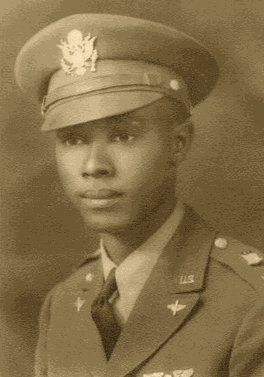
Mac Ross was a U.S. Army Air Force officer and combat fighter pilot during World War II. A member of the Tuskegee Airmen, he commanded the 100th Fighter Squadron and served as the Group Operations Officer for the 332nd Fighter Group.
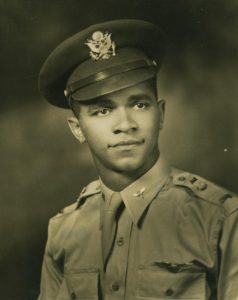
Charles DeBow was an officer in the U.S. Army Air Force and combat fighter pilot and commanding officer of the 332nd Fighter Group's 301st Fighter Squadron, best known as the prodigious, all-African American Tuskegee Airmen. He was one of the 1,007 documented Tuskegee Airmen Pilots.

George Levi Knox II was a U.S. Army Air Force/U.S. Air Force officer, combat fighter pilot and Adjutant with the all-African American 332nd Fighter Group's 100th Fighter Squadron, best known as the Tuskegee Airmen. One of the 1,007 documented Tuskegee Airmen Pilots, he was a member of the Tuskegee Airmen's third-ever aviation cadet class, and one of the first twelve African Americans to become combat fighter pilots. He was the second Indiana native to graduate from the Tuskegee Advanced Flying School (TAFS).
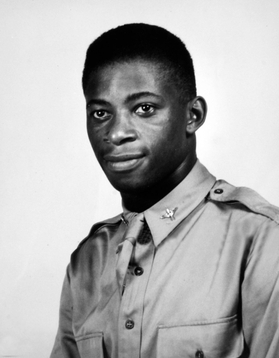
Willie Howell Fuller was a U.S. Army Air Force/U.S. Air Force officer, combat fighter pilot, and combat flight instructor with the 332nd Fighter Group's 99th Pursuit Squadron, best known as the Tuskegee Airmen or "Red Tails". He was the first black flight instructor for the single engine planes at Tuskegee. He was the only black flight instructor until December 1944. He was one of 1,007 documented Tuskegee Airmen Pilots. He flew 76 combat missions.
Yancey Williams was a U.S. Army Air Force/U.S. Air Force officer and pilot with the 85th Fighter-Interceptor Squadron and the 332nd Fighter Group, best known as the Tuskegee Airmen or "Red Tails".
Vernon V. Haywood was a U.S. Army Air Force officer, combat fighter pilot/jet pilot, and commanding officer of the 332nd Fighter Group's 302nd Fighter Squadron, a component of the Tuskegee Airmen.
Raymond Cassagnol was a Haitian Air Force officer/flight instructor, alleged Haitian rebel leader, and one of the first Haitian Tuskegee Airmen, "Red Tails," or “Schwartze Vogelmenschen” or among enemy German pilots. Cassagnol was an aviation classmate and roommate of Daniel James Jr., the first-ever African American four-star general.

William Hugo Holloman III was a U.S. Army Air Force officer, combat fighter pilot, and high-profile member of the prodigious 332nd Fighter Group's 99th Fighter Squadron, best known as the Tuskegee Airmen, "Red Tails," or “Schwarze Vogelmenschen” among enemy German pilots.

James Alonzo Walker was an American aviator from Manning, South Carolina who served as a Tuskegee Airman during World War II. He flew more than 102 missions in the European Theatre of WWII, and was shot down in action over Serbia at the time occupied Kingdom of Yugoslavia by Third Reich ( Germany). He was saved in Halyard Mission known in Serbian as in July 1944t, by Chetniks and general Dragoljub Draža Mihailović. He served in the military until 1964. He became the first African American commander of an integrated unit in 1950.
